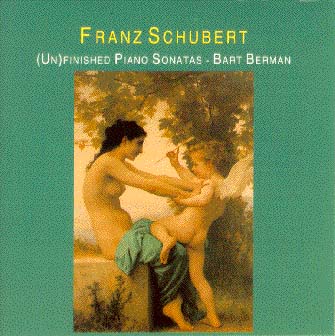|
NOTES ON FRANZ SCHUBERT Completing the Unfinished Sonatas by Bart Berman |
|
|
Schubert’s unfinished piano sonata pose a problem for performers: should incomplete sonata movements be played at all, or should they only be performed up to the very point where the composer ceased writing them? Should they be performed with someone else’s ending, based on the thematic material Schubert left us? Among those who tried to compose endings to the sonata movements discussed above, are Willy Rehberg [Schott Edition], Ernst Krenek [Universal] and Paul Badura-Skoda [Henle]. Henceforth I will analyze the best known uncompleted sonata, piano sonata in C major, D 840 and its completion. The principal theme in the first movement (Moderato) is a 4/4 melody, reminiscent of the A-minor sonata D 845, composed in the same year 1825. But unlike D 845’s melancholic mood, this one has a brighter, happier atmosphere. The theme is then repeated in a march-like manner, after which both second theme and codetta, leading into the key of G major, turn out to be variations of the same principal theme. Add to this the subsequent Development section’s sole dependence on motives already heard, and a definition of the whole movement as monothematic suggests itself strongly. This section features the martial character of the principal theme’s continuation, together with an almost orchestral sense of drama. The Recapitulation omits the initial, more intimate setting of the principal theme, only to return at the final moments of the Coda. An Andante in C minor follows, quietly undulating in 6/8 rhythm. A second melody in A flat major is interrupted by fast-rolling scales in the Bass and by forceful chords. The first melody then reappears in a varied form, and it also concludes the entire movement after the second one is heard in C major. The Menuetto in A flat major has shed its traditional dance character, leaving us - however happily - saddled with a movement difficult to define. The melodiously flowing outset of it could never be called a Scherzo. This changes, however, in a most dynamic way after the sole repeat sign; the first page or so doesn’t have a repeat, but rather a variation on the already presented material in A major, a semitone higher. The stormy episode having calmed down, only a few bars of the slightly altered main melody return in A major. It is here that Schubert stopped composing, leaving us stranded in a key which would lead still higher up to B flat major, if pursued along the same lines. My solution to this problem is to reverse the order of the tonalities, as compared to the first page, and to make the repeat before the ‘variation’ follows again - because this maintains the same logical sequence, back into the tempestuous intermezzo, that Schubert himself pursued at the repeat sign. The Trio has been written out in full; it is a tender G sharp minor, a more easily readable variant of an A flat minor which would be the Menuetto’s companion minor mode.
The last movement is one of those Finales to which a composer,
probably in mere oversight, gave the title of Rondo, although
the movement owes more to the sonata form. My own arrangement of this
movement, which Schubert left unfinished, follows the sonata-like
tendencies evident in it. Accordingly, in today’s program I avoided the
designation ‘Rondo.’ The 2/4 main theme in triplets, followed by a
motive in eighth notes, shows in its dimensions the ‘heavenly length’
Schumann admired so (un)apologetically. A march-like second theme
begins and is then being heard more flowingly in the left hand, the
right hand playing virtuosic 16ths above it. The Development features a
slightly altered main theme in A minor, the left hand accompanying
nervously in triplets rather than with gentle chords. Again, the
original music stops abruptly and by chance, once more in A major.
In my opinion, the composer – far from being the careless artist who starts and relinquishes pieces at will – adheres here to a pattern he can almost be proven to follow in all unfinished sonatas: that of breaking off at a stage where any new musical material will be exhausted. In this Finale, that would mean the Recapitulation is either just about to enter, or that it is quite near. In fact, I choose to combine these two possibilities, continuing Schubert’s last measures as if they constituted a mock beginning of the next section; and then modulating back to the C major of the real Recapitulation, in which the left hand triplets are retained, however. In addition, I added a little fugato on the main theme. PREVIOUS PAGE: THE UNFINISHED PIANO SONATAS
|
NOTES ON FRANZ SCHUBERT Introduction Analysis of Five Piano Duets The Unfinished Piano Sonatas Completing the Unfinished Sonatas Questions & Answers Links BART BERMAN
CURRENT ENSEMBLES COMPOSITION & ARRANGEMENTS IN MEMORIAM CONTACT |
